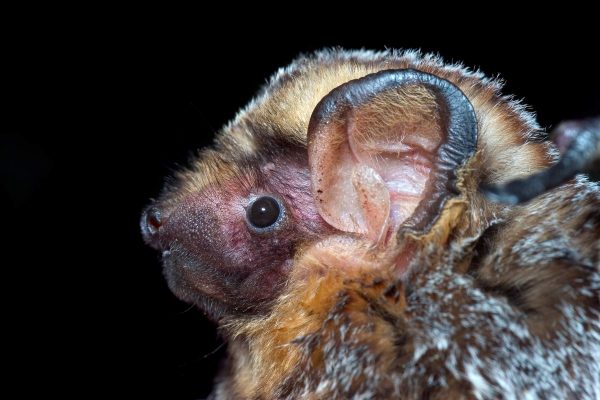| Wind Watch is a registered educational charity, founded in 2005. |
Hoary bat numbers decline amid wind turbine expansion
Credit: Michael Kohn | The Bulletin | Sept. 21, 2019 | www.bendbulletin.com ~~
Bats are facing multiple threats in the Pacific Northwest as both white-nose syndrome and wind turbines are threatening to decimate their population numbers, according to a study by Oregon State University—Cascades.
The hoary bat – which does not hibernate but instead migrates south for the winter – faces an uncertain future because its numbers have declined at a rate of 2% per year, according to Tom Rodhouse, one of the authors of the study.
The cause of the hoary bat decline is believed to be the wind turbines on industrial wind farms, a growing phenomenon in Oregon and Washington state.
Oregon and Washington combined have 3,600 wind turbines with 6,300 megawatts of installed generating capacity. In both states, the majority of the wind farms are clustered near the Columbia River Gorge, east of The Dalles. Other farms in the region can be found near Ellensburg and Walla Walla in Washington, and Baker City in Oregon.
While collisions with the propellers on wind farms cause many of the deaths, barotrauma is another problem.
Barotrauma can occur when bats fly through low pressure zones created by the spinning blades of a wind turbine. The sudden change in pressure causes their lungs to expand faster than the bats can exhale, resulting in burst vessels that fill their tiny lungs with blood, said Rodhouse, an ecologist with the National Park Service and a courtesy faculty member at OSU-Cascades. Courtesy faculty members serve on the faculty but are not paid by the university.
“This and direct collisions with the turbines has resulted in millions of bat deaths over the last two decades,” said Rodhouse.
Hoary bats fly straight into the danger zones, usually while migrating south for the winter, because their sophisticated sonar capabilities are unable to detect the pressure drops, said Rodhouse.
The physiological effect of barotrauma is not unlike the bends – also known as decompression sickness – that divers experience. The lungs of birds are tube-like and more rigid, with strong capillaries, making them less vulnerable to the pressure changes near wind turbines.
White-nose syndrome, a deadly disease that has affected bat populations in other parts of the country, is not affecting the hoary bat, said Rodhouse. This disease kills some bat species in winter during hibernation, but hoary bats migrate to warmer climates instead of hibernating.
“Wind energy is devastating the migrating species that aren’t affected by white-nose syndrome. So it’s kind of a double whammy in terms of two new threats that, in sum, are hitting pretty much all our bats,” Rodhouse said.
Widespread across North America, hoary bats are named after their distinctive white-tipped fur coats, which are frosty in appearance. These furry, winged mammals hunt at night and feed on a steady diet of crop-eating pests, reducing farmers’ reliance on expensive and potentially harmful pesticides.
The report on declining bat numbers was published in Ecology and Evolution, a biweekly open-access scientific journal. Scientists from the U.S. Fish and Wildlife Service, Montana State University, Willamette National Forest and the U.S. Geological Survey helped to co-author the paper. Bat population surveys were conducted between 2003 and 2010 and again from 2016 to 2018.
Rodhouse was not able to pinpoint the number of bats killed by wind turbines but said it’s in the “order of millions.” Other factors contributing to the hoary bat population decline may include habitat loss and new types of pesticides, since these bats are dependent on insects for food.
Population recovery can take years because the animals are slow to reproduce in the Pacific Northwest, with females producing just one to three pups per year, Rodhouse said.
But there are ways to combat the problem, said Cris Hein, senior project leader for the environmental portfolio for the National Renewable Energy Laboratory, a lab for the U.S. Department of Energy.
Technology to protect the bats include ultrasonic deterrents, essentially high-frequency sounds that may prevent bats from approaching the wind turbines. Hein said the bats are attracted to the turbines, possibly as places to roost, find food or mate, and the goal is to find technologies to keep them away.
“We do see bats spending a lot of time around turbines. They may see it as a resource and may be putting themselves at risk,” Hein said.
Another option is simply to turn off the turbines in late summer and fall when bats are migrating. Several options may need to be employed to have the greatest effect.
“Ultrasonic deterrents seem to work for hoary bats but not all bats. We are trying to figure out options. There are curtailment strategies – when to slow the turbine blades. The goal is to reduce fatalities but also maximize energy production,” Hein said.
Rodhouse says these types of strategies need to be employed as soon as possible or hoary bats could face extinction by the middle of this century.
“There has been a fairly substantial drop in hoary bat population already, and there are fewer numbers returning from their migration. I’m concerned that if the trend persists at this rate, then there is a real risk of extinction,” said Rodhouse.
This article is the work of the source indicated. Any opinions expressed in it are not necessarily those of National Wind Watch.
The copyright of this article resides with the author or publisher indicated. As part of its noncommercial educational effort to present the environmental, social, scientific, and economic issues of large-scale wind power development to a global audience seeking such information, National Wind Watch endeavors to observe “fair use” as provided for in section 107 of U.S. Copyright Law and similar “fair dealing” provisions of the copyright laws of other nations. Send requests to excerpt, general inquiries, and comments via e-mail.
| Wind Watch relies entirely on User Contributions |
 (via Stripe) |
 (via Paypal) |
Share:


